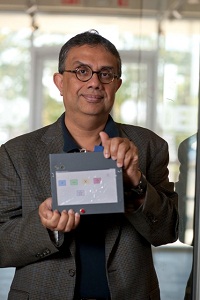Rice University to use solar to educate rural children
 Imagine a small, rural Indian village, a crowd of children in school—a circle out in the sun with no electricity. How can their education start to compare to what is offered to children in cities or more developed villages? Rice University Professor Krishna Palem is working on a solution—solar-powered educational tablets filled with lessons for rural students.
Imagine a small, rural Indian village, a crowd of children in school—a circle out in the sun with no electricity. How can their education start to compare to what is offered to children in cities or more developed villages? Rice University Professor Krishna Palem is working on a solution—solar-powered educational tablets filled with lessons for rural students.
Palem is working with Singapore's Nanyang Technological University to make affordable, solar-powered electronic tablets available to some of the estimated 100 million Indian children who go to schools that don’t have electricity.
He said the tablet, known as the I-Slate, is being developed because it has been found to be useful in educating children who are deprived of two resources. “Electricity being one and human teachers,” he said.
But why create a solar-powered device?
“In this particular instance, the location,” he said. “It has sunlight 365 days a year and lots of it. [The students] just have to sit in the classroom and it works.”
At this point, the prototype tablets still operate on battery power. But ultimately, they will operate on solar power.
To get there, the I-Slates must operate on significantly less power than a laptop.
“We are targeting in terms of the energy budget 5 watts or 4 watts [of consumption]. A laptop would take about 50 watts,” Palem said.
In order to achieve this, the development team is making the content for the device as light, or non-demanding, as possible.
The tablets will not act like a laptop, not even like the devices developed through the One Laptop Per Child program, Palem explained.
“It’s a single function-device,” he said.
Palem likened it to cheap, monochromatic handheld video games from the 1980’s.
“It’s that type of device,” he said. “While the goal is to improve lives, the platform is not that of a computer. It will be used to show lessons, for now we are focusing on mathematics.”
Toward the end of November, the devices will go through their second testing phase.
“With each study, we are making it more and more usable,” he said. “We don’t want to lock it into any design at this point. We are about two studies away from having a real competent idea.”
Pictured: Rice University's Krishna Palem holding a prototype of the I-slate. Image courtesy of Rice University.



